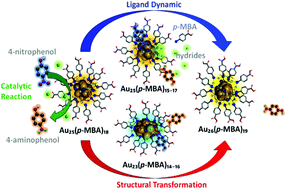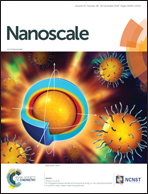Hydride-induced ligand dynamic and structural transformation of gold nanoclusters during a catalytic reaction†
Abstract
Quasi-homogeneous ligand-protected gold nanoclusters (Au NCs) with atomic precision and well-defined structure offer great opportunity for exploring the catalytic nature of nanogold catalysts at a molecular level. Herein, using real-time electrospray ionization mass spectrometry (ESI-MS), we have successfully identified the desorption and re-adsorption of p-mercaptobenzoic acid (p-MBA) ligands from Au25(p-MBA)18 NC catalysts during the hydrogenation of 4-nitrophenol in solution. This ligand dynamic (desorption and re-adsorption) would initiate structural transformation of Au25(p-MBA)18 NC catalysts during the reaction, forming a mixture of smaller Au NCs (Au23(p-MBA)16 as the major species) at the beginning of catalytic reaction, which could further be transformed into larger Au NCs (Au26(p-MBA)19 as the major species). The adsorption of hydrides (from NaBH4) is identified as the determining factor that could induce the ligand dynamic and structural transformation of NC catalysts. This study provides fundamental insights into the catalytic nature of Au NCs, including catalytic mechanism, active species and stability of Au NC catalysts during a catalytic reaction.



 Please wait while we load your content...
Please wait while we load your content...